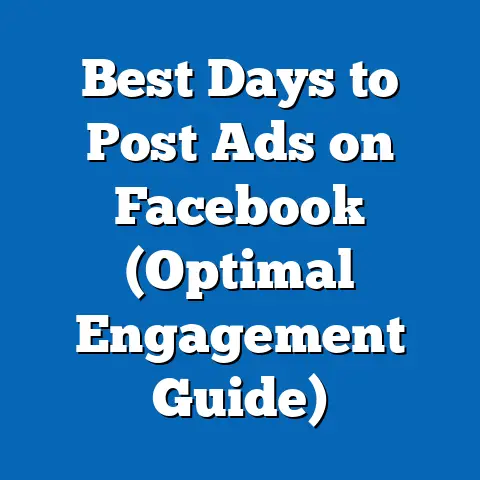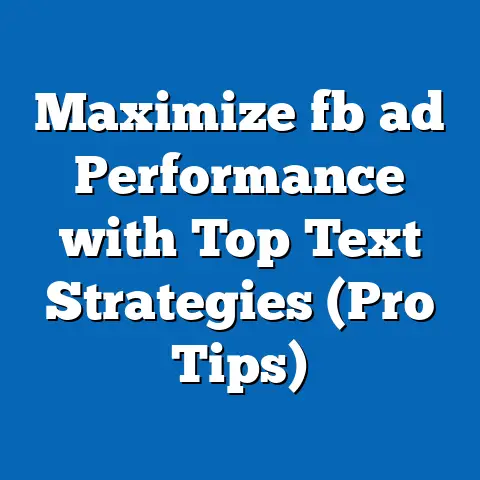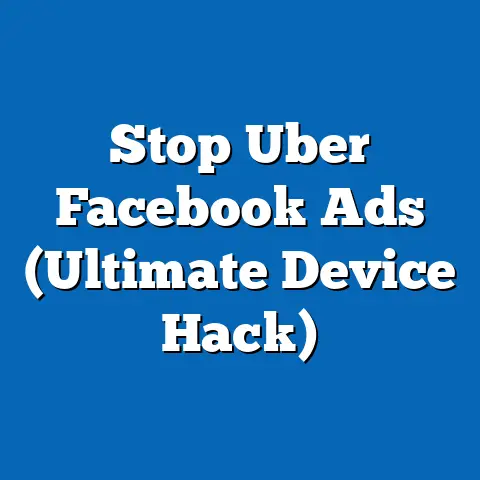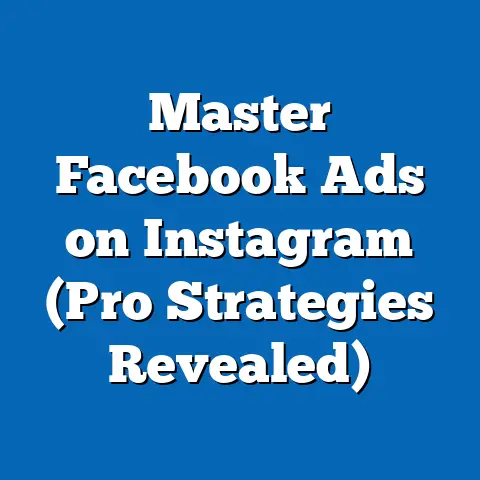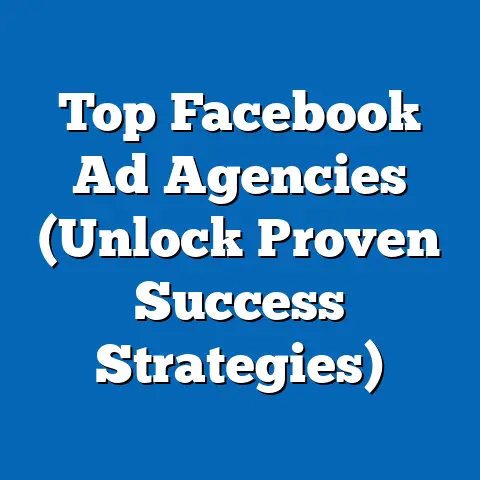Remove Facebook Ads Effectively (Expert Step-by-Step Guide)
Digital advertising is a constantly shifting landscape, and if there’s one thing I’ve learned over years of managing Facebook ad campaigns, it’s that adaptability is key. You can’t just set it and forget it. Sometimes, the best thing you can do for your campaign is to strategically remove ads. This might sound counterintuitive, but trust me, knowing when and how to pull the plug on underperforming or irrelevant ads is crucial for maximizing your ROI.
Understanding Facebook Ads and Their Importance
Facebook advertising, with its massive reach and sophisticated targeting capabilities, remains a powerhouse for businesses of all sizes. Think about it: With billions of active users, Facebook offers an unparalleled opportunity to connect with potential customers based on demographics, interests, behaviors, and even custom audiences.
The Allure of Facebook Ads:
- Reach: As of Q4 2023, Facebook boasts nearly 3 billion daily active users. This sheer scale means you have a massive pool of potential customers to tap into.
- Targeting: Facebook’s granular targeting options are a game-changer. I’ve personally seen campaigns skyrocket when we dialed in the right audience based on specific interests, purchase behaviors, or even life events. You can even upload your own customer lists to create lookalike audiences, extending your reach to people who share similar characteristics with your existing customers.
- Cost-Effectiveness: Compared to traditional advertising channels, Facebook ads can be incredibly cost-effective. You have control over your budget, allowing you to start small and scale up as you see results.
- Variety of Ad Formats: Facebook offers a diverse range of ad formats to suit different objectives, from simple image ads to engaging video ads and interactive carousel ads.
A Quick Look at Common Facebook Ad Types:
- Image Ads: These are your basic, visually-driven ads. They’re great for showcasing products or services with a single, compelling image. I’ve found that high-quality, eye-catching visuals are essential for image ads to stand out in a crowded newsfeed.
- Video Ads: Video ads are incredibly engaging and can be used to tell stories, demonstrate products, or share testimonials. Short, attention-grabbing videos tend to perform best.
- Carousel Ads: Carousel ads allow you to showcase multiple images or videos in a single ad unit. This is perfect for highlighting different features of a product or telling a multi-part story. I’ve used carousel ads to display different angles of a product and show it in use.
- Collection Ads: These ads are designed for e-commerce businesses, allowing users to browse and purchase products directly from the ad.
- Lead Generation Ads: These ads make it easy for users to sign up for newsletters, request quotes, or download resources directly within Facebook.
Why Remove Ads, Even When They’re “Working”?
So, with all these advantages, why would you ever want to remove Facebook ads? Here are a few compelling reasons:
- Budget Constraints: Sometimes, your budget simply isn’t unlimited. Removing underperforming ads allows you to reallocate resources to more promising campaigns.
- Changing Marketing Goals: Your business goals might evolve over time. An ad that was once aligned with your objectives may no longer be relevant. For example, you might shift from brand awareness to lead generation, requiring a different ad strategy.
- Poor Performance Metrics: This is the most obvious reason. If an ad isn’t delivering the desired results (low click-through rate, high cost per acquisition, etc.), it’s time to cut your losses and move on.
- Audience Fatigue: Even a well-performing ad can lose its effectiveness over time as your target audience becomes saturated with the message.
- Seasonality: Some ads are only relevant during specific times of the year. For example, a promotion for winter coats wouldn’t make sense in the middle of summer.
The Power of Adaptability: A Statistic to Consider:
According to a recent study by HubSpot, businesses that actively manage and optimize their ad campaigns see a 20-30% improvement in ROI compared to those that simply set and forget. This highlights the importance of constantly monitoring and adjusting your ad strategy, including removing ads when necessary.
My Own Experience:
I remember one campaign I ran for a local restaurant. We were promoting a new lunch special using a carousel ad. Initially, the ad performed exceptionally well, driving a significant increase in lunchtime traffic. However, after a few weeks, the performance started to decline. We analyzed the data and discovered that the audience was experiencing ad fatigue. By removing the original ad and creating a fresh, slightly different version with new visuals and copy, we were able to reignite engagement and get the campaign back on track.
Key Takeaway: Facebook advertising is a dynamic process. Don’t be afraid to remove ads that aren’t performing well or no longer align with your goals. It’s a strategic move that can ultimately lead to better results.
Identifying the Right Time to Remove Facebook Ads
Knowing when to remove a Facebook ad is just as important as knowing how. You don’t want to pull the plug prematurely on an ad that might just need a little tweaking. On the other hand, you don’t want to keep throwing money at an ad that’s clearly not working. So, how do you know when it’s time to say goodbye?
The key is to closely monitor your key performance indicators (KPIs) and look for specific signs that an ad is underperforming.
Key Performance Indicators (KPIs) to Watch:
- Click-Through Rate (CTR): This measures the percentage of people who see your ad and click on it. A low CTR indicates that your ad isn’t resonating with your target audience.
- Interpretation: A good CTR varies depending on the industry and ad objective, but generally, a CTR below 1% is a cause for concern.
- Relationship to Other Metrics: A low CTR can lead to a higher cost per click (CPC) and a lower overall return on ad spend (ROAS).
- Conversion Rate: This measures the percentage of people who click on your ad and then complete a desired action, such as making a purchase, signing up for a newsletter, or filling out a form.
- Interpretation: A low conversion rate suggests that your landing page isn’t effectively converting traffic into customers.
- Relationship to Other Metrics: A low conversion rate can significantly impact your cost per acquisition (CPA) and ROAS.
- Cost Per Click (CPC): This measures the average cost you pay each time someone clicks on your ad.
- Interpretation: A high CPC can quickly eat into your budget and reduce your overall reach.
- Relationship to Other Metrics: A high CPC can be caused by low ad relevance, a competitive audience, or a poor quality score.
- Cost Per Acquisition (CPA): This measures the average cost you pay to acquire a new customer or lead through your ad campaign.
- Interpretation: A high CPA indicates that your ad campaign is not cost-effective.
- Relationship to Other Metrics: CPA is directly influenced by CPC and conversion rate.
- Return on Ad Spend (ROAS): This measures the revenue you generate for every dollar you spend on advertising.
- Interpretation: A low ROAS means you’re not getting enough return on your investment.
- Relationship to Other Metrics: ROAS is the ultimate measure of your ad campaign’s profitability.
- Relevance Score: Facebook assigns a relevance score to each ad based on how relevant it is to the target audience.
- Interpretation: A low relevance score indicates that your ad isn’t resonating with your target audience and can lead to higher costs and lower reach.
- Relationship to Other Metrics: Relevance score directly impacts CPC and ad delivery.
- Frequency: This measures the average number of times each person in your target audience has seen your ad.
- Interpretation: A high frequency can lead to ad fatigue and a decrease in engagement.
- Relationship to Other Metrics: High frequency can negatively impact CTR and relevance score.
- Interpretation: A good CTR varies depending on the industry and ad objective, but generally, a CTR below 1% is a cause for concern.
- Relationship to Other Metrics: A low CTR can lead to a higher cost per click (CPC) and a lower overall return on ad spend (ROAS).
- Interpretation: A low conversion rate suggests that your landing page isn’t effectively converting traffic into customers.
- Relationship to Other Metrics: A low conversion rate can significantly impact your cost per acquisition (CPA) and ROAS.
- Interpretation: A high CPC can quickly eat into your budget and reduce your overall reach.
- Relationship to Other Metrics: A high CPC can be caused by low ad relevance, a competitive audience, or a poor quality score.
- Interpretation: A high CPA indicates that your ad campaign is not cost-effective.
- Relationship to Other Metrics: CPA is directly influenced by CPC and conversion rate.
- Interpretation: A low ROAS means you’re not getting enough return on your investment.
- Relationship to Other Metrics: ROAS is the ultimate measure of your ad campaign’s profitability.
- Interpretation: A low relevance score indicates that your ad isn’t resonating with your target audience and can lead to higher costs and lower reach.
- Relationship to Other Metrics: Relevance score directly impacts CPC and ad delivery.
- Interpretation: A high frequency can lead to ad fatigue and a decrease in engagement.
- Relationship to Other Metrics: High frequency can negatively impact CTR and relevance score.
The Importance of A/B Testing:
A/B testing, also known as split testing, is a crucial tool for optimizing your Facebook ad campaigns. It involves creating two or more versions of an ad with slight variations (e.g., different headlines, images, or call-to-actions) and then testing them against each other to see which performs better.
- Interpreting A/B Testing Results: If one version of your ad consistently outperforms the other, it’s a clear sign that you should remove the underperforming version and focus on the winning variation.
- Example: Let’s say you’re A/B testing two different headlines for your ad. After a week of running the test, you notice that Headline A has a CTR of 2%, while Headline B has a CTR of only 0.5%. This indicates that Headline A is more effective at attracting clicks, and you should remove the ad with Headline B.
Signs an Ad Isn’t Performing Well:
- Low Engagement: If your ad is generating very few likes, comments, or shares, it’s a sign that it’s not resonating with your audience.
- Negative Feedback: If people are hiding your ad, reporting it as spam, or leaving negative comments, it’s a clear indication that something is wrong.
- Audience Fatigue: As mentioned earlier, even a well-performing ad can lose its effectiveness over time as your target audience becomes saturated with the message. Watch for a decline in CTR and engagement as a sign of audience fatigue.
Real-World Example:
I worked with an e-commerce client who was running a Facebook ad campaign to promote a new line of clothing. The initial ad performed well, but after a few weeks, the sales started to decline. We analyzed the data and discovered that the ad frequency was very high, meaning that people were seeing the ad multiple times per day. This led to ad fatigue and a decrease in engagement. We decided to remove the original ad and create a new version with fresh visuals and copy. We also implemented frequency capping to limit the number of times each person saw the ad. As a result, we were able to reignite engagement and get the sales back on track.
Another Story:
I had a client in the travel industry running a campaign to promote a specific tour package. After a week, the ad was getting plenty of clicks, but the conversion rate was abysmal. People were clicking on the ad, but they weren’t actually booking the tour. We investigated the landing page and discovered that it was slow to load and difficult to navigate on mobile devices. We immediately removed the ad and focused on optimizing the landing page. Once the landing page was improved, we relaunched the ad, and the conversion rate skyrocketed.
Key Takeaway: Don’t rely solely on gut feeling when deciding whether to remove a Facebook ad. Closely monitor your KPIs, conduct A/B testing, and be aware of the signs that an ad isn’t performing well. Data-driven decision-making is the key to optimizing your ad campaigns and maximizing your ROI.
Now, let’s get down to the nitty-gritty of how to actually remove it from Facebook Ads Manager. This is a straightforward process, but it’s important to follow the steps carefully to avoid any accidental deletions or disruptions to your other campaigns.Step 1: Log into Facebook Ads Manager
This might seem obvious, but let’s start with the basics.
- Go to www.facebook.com/adsmanager.
- Log in using your Facebook account credentials. Make sure you’re logging in with the account that has access to the ad account you want to manage.
- If you have multiple ad accounts, select the correct one from the dropdown menu in the top left corner.
Pro Tip: Bookmark the Ads Manager URL for quick access. I personally have it pinned to my browser for instant access.
Step 2: Locate the Campaign, Ad Set, or Ad
Once you’re in Ads Manager, you’ll need to navigate to the specific campaign, ad set, or ad that you want to remove. Facebook Ads Manager is structured in a hierarchical way:
- Campaigns: These are the top-level containers for your advertising efforts. They define your overall objective (e.g., brand awareness, lead generation, conversions).
- Ad Sets: These define your target audience, budget, and schedule. Each campaign can contain multiple ad sets, allowing you to target different segments of your audience with different bids and schedules.
- Ads: These are the individual ads that are displayed to your target audience. Each ad set can contain multiple ads, allowing you to test different creatives and messaging.
To locate the ad you want to remove, use the navigation menu on the left side of the screen. You can filter by campaign, ad set, or ad. You can also use the search bar to quickly find a specific ad by name or ID.
Example: Let’s say you want to remove an ad that’s part of a campaign called “Summer Sale.”
- Click on the “Campaigns” tab.
- Find the “Summer Sale” campaign in the list and click on it.
- This will take you to a list of ad sets within the “Summer Sale” campaign. Select the relevant ad set.
- Finally, you’ll see a list of ads within that ad set. Find the ad you want to remove.
Step 3: Analyze Performance Metrics (One Last Time!)
Before you pull the trigger, take one last look at the ad’s performance metrics. This is your final opportunity to confirm that the ad is indeed underperforming and that removing it is the right decision.
- Focus on the KPIs: Pay close attention to the KPIs we discussed earlier (CTR, conversion rate, CPC, CPA, ROAS, relevance score, frequency).
- Compare to Benchmarks: Compare the ad’s performance to your industry benchmarks and your own historical data. Is it significantly underperforming?
- Consider the Timeframe: Make sure you’re looking at the data over a sufficient timeframe. Don’t make a decision based on just a few hours of data. I typically look at data over at least a week, if not longer.
- Look for Trends: Are the performance metrics consistently declining over time? This is a strong indication that the ad is losing its effectiveness.
Step 4: Selecting the Ad for Removal
Once you’ve confirmed that the ad should be removed, it’s time to select it.
- In the list of ads, find the ad you want to remove.
- Click the checkbox next to the ad’s name. This will select the ad.
Step 5: Removing the Ad
Now for the moment of truth! There are two ways to “remove” an ad on Facebook:
- Turning it Off (Pausing): This is the most common and recommended approach. Turning off an ad simply pauses it, preventing it from being shown to your target audience. The ad still exists in your Ads Manager, and you can reactivate it later if you change your mind.
- Deleting it: This permanently removes the ad from your Ads Manager. You cannot undo this action. I generally advise against deleting ads unless you’re absolutely sure you’ll never need them again.
Here’s how to turn off (pause) an ad:
- With the ad selected, look for the toggle switch next to the ad’s name. It will likely be set to “On.”
- Click the toggle switch to turn it “Off.” The ad’s status will change to “Inactive” or “Paused.”
Here’s how to delete an ad (use with caution!):
- With the ad selected, click the “Edit” button.
- In the edit window, look for the “Delete” button (it’s usually located at the bottom of the window).
- Click the “Delete” button.
- Facebook will ask you to confirm that you want to delete the ad. Click “Delete” again to confirm.
Step 6: Documenting the Removal Process
This is a step that many advertisers skip, but it’s incredibly important for learning and improving your future campaigns.
- Create a Documentation System: I recommend creating a simple spreadsheet or document to track the ads you remove.
- Include Key Information: For each ad, record the following information:
- Ad Name
- Campaign Name
- Ad Set Name
- Date of Removal
- Reason for Removal (be specific!)
- Key Performance Metrics (CTR, conversion rate, CPC, CPA, ROAS)
- Lessons Learned
- Ad Name
- Campaign Name
- Ad Set Name
- Date of Removal
- Reason for Removal (be specific!)
- Key Performance Metrics (CTR, conversion rate, CPC, CPA, ROAS)
- Lessons Learned
Example Documentation Template:
| Ad Name | Campaign Name | Ad Set Name | Date of Removal | Reason for Removal | CTR | Conversion Rate | CPC | CPA | ROAS | Lessons Learned |
|---|---|---|---|---|---|---|---|---|---|---|
| Summer Sale Ad 1 | Summer Sale | Women Ages 25-34 | 2024-01-26 | Low CTR, Audience Fatigue | 0.4% | 0.1% | $1.50 | $150 | 0.5x | Need to refresh creative more frequently, experiment with different targeting options. |
| Product X Ad 2 | New Arrivals | All Visitors | 2024-01-26 | High CPA, Landing page not optimized for mobile | 1.2% | 0.05% | $0.75 | $250 | 0.2x | Landing page needs to be faster and more mobile-friendly. |
| Ad Name | Campaign Name | Ad Set Name | Date of Removal | Reason for Removal | CTR | Conversion Rate | CPC | CPA | ROAS | Lessons Learned |
|---|---|---|---|---|---|---|---|---|---|---|
| Summer Sale Ad 1 | Summer Sale | Women Ages 25-34 | 2024-01-26 | Low CTR, Audience Fatigue | 0.4% | 0.1% | $1.50 | $150 | 0.5x | Need to refresh creative more frequently, experiment with different targeting options. |
| Product X Ad 2 | New Arrivals | All Visitors | 2024-01-26 | High CPA, Landing page not optimized for mobile | 1.2% | 0.05% | $0.75 | $250 | 0.2x | Landing page needs to be faster and more mobile-friendly. |
Step 7: Analyzing the Impact of the Removal
After you remove an ad, it’s important to monitor the overall performance of your campaign to see how the removal has affected your results.
- Track Key Metrics: Keep a close eye on your KPIs, such as CTR, conversion rate, CPC, CPA, and ROAS.
- Look for Improvements: Did the removal of the underperforming ad lead to an improvement in your overall campaign performance?
- Identify Any Negative Impacts: Did the removal have any unintended consequences? For example, did your overall reach decrease?
- Adjust Your Strategy: Based on your analysis, adjust your ad strategy accordingly. You might need to reallocate your budget, refine your targeting, or create new ad creatives.
Key Takeaway: Removing a Facebook ad is not just about turning it off. It’s about making a data-driven decision, documenting the process, and analyzing the impact of the removal on your overall campaign performance.
Post-Removal Strategies
So, you’ve bravely removed an underperforming ad. Congratulations! But the work doesn’t stop there. What you do after removing an ad is just as important as the removal itself. It’s time to strategize and make sure those freed-up resources are put to good use.
Reallocating Budget and Resources:
The first and most obvious step is to reallocate the budget that was previously allocated to the removed ad. You have several options here:
- Invest in More Successful Ads: Identify the ads that are performing well and allocate more budget to them. This is a great way to amplify your results and drive even more conversions. I often look for ads with a high ROAS and scale their budgets aggressively.
- Create New Ad Content: Use the insights you gained from the removal process to create new ad creatives. Experiment with different headlines, images, videos, and call-to-actions.
- Refine Your Targeting: Re-evaluate your target audience and make sure you’re reaching the right people. Experiment with different demographics, interests, and behaviors.
- Test New Ad Placements: Facebook offers a variety of ad placements, including Facebook Feed, Instagram Feed, Audience Network, and Messenger. Test different placements to see which ones perform best for your target audience.
- Experiment with Different Ad Objectives: Facebook offers a variety of ad objectives, such as brand awareness, reach, traffic, engagement, lead generation, and conversions. Experiment with different objectives to see which ones align best with your business goals.
Creating New Ad Content Based on Insights:
The removal process provides valuable insights that you can use to create more effective ad content.
- Analyze the Data: Review the performance metrics of the removed ad and identify any patterns or trends. What worked well? What didn’t work?
- Consider the Reason for Removal: Was the ad removed due to low CTR, low conversion rate, audience fatigue, or negative feedback? This will help you understand what went wrong and how to avoid making the same mistakes in the future.
- Brainstorm New Ideas: Based on your analysis, brainstorm new ideas for ad creatives. Think about different headlines, images, videos, and call-to-actions that might resonate better with your target audience.
- Test Your Ideas: Create several different versions of your new ad and A/B test them against each other to see which performs best.
Example:
Let’s say you removed an ad because it had a low CTR. After analyzing the data, you discover that the headline was not compelling enough. You brainstorm several new headlines and create three different versions of the ad, each with a different headline. You A/B test these ads against each other and discover that one headline significantly outperforms the others. You then remove the underperforming ads and focus on the winning headline.
Re-Engaging the Audience:
Just because you removed an ad doesn’t mean you should give up on the audience that was targeted by that ad. There are several ways to re-engage them:
- Create a Custom Audience: Create a custom audience of people who saw your removed ad but didn’t convert.
- Retarget Them with a Different Ad: Retarget this audience with a different ad that offers a special discount or promotion.
- Use a Different Ad Format: Try using a different ad format, such as a video ad or a carousel ad.
- Refine Your Messaging: Make sure your messaging is clear, concise, and relevant to their needs.
- Offer Value: Provide valuable content or resources that will help them solve their problems.
My Personal Strategy:
When I remove an ad, I immediately look at my top-performing ads and see if I can scale them. If I have the budget, I might even duplicate the ad set and increase the budget on the new ad set to see if I can reach a wider audience. I also spend time brainstorming new ad creatives based on the data I collected from the removed ad. I’m always looking for ways to improve my campaigns and drive better results.
Key Takeaway: Removing an ad is an opportunity to learn, adapt, and improve your overall campaign performance. By reallocating your budget, creating new ad content, and re-engaging your audience, you can turn a negative situation into a positive one.
But before you go off and start deleting everything in sight, let’s talk about some common mistakes that businesses make when removing Facebook ads. Avoiding these pitfalls can save you time, money, and a whole lot of frustration.Mistake #1: Acting Too Quickly
This is probably the most common mistake I see. Businesses get impatient and pull the plug on an ad after just a few hours of underperformance. Remember, Facebook’s algorithm needs time to learn and optimize your ad. Give your ads at least 24-48 hours (ideally a week) to gather enough data before making a decision.
Example:
I had a client who launched a new Facebook ad campaign to promote a flash sale. After just 6 hours, the ad wasn’t generating any sales, so they panicked and removed it. I convinced them to relaunch the ad and give it a full 24 hours to run. By the end of the day, the ad had generated a significant number of sales. They almost missed out on a successful campaign because they acted too quickly.
Mistake #2: Not Analyzing Data Thoroughly
Another common mistake is to make decisions based on gut feeling rather than data. Don’t just look at the overall performance of the ad. Dive deeper into the metrics and try to understand why it’s underperforming. Is it the targeting? The creative? The landing page? Without a thorough analysis, you’re just guessing.
Example:
I worked with a company that was running a Facebook ad campaign to generate leads. The ad was getting a lot of clicks, but the conversion rate was very low. They assumed that the problem was with the ad itself, so they started experimenting with different creatives. However, after several weeks of testing, they still weren’t seeing any improvement. I suggested that they analyze their landing page. It turned out that the landing page was slow to load and difficult to navigate on mobile devices. Once they optimized the landing page, their conversion rate skyrocketed.
Mistake #3: Deleting Ads Instead of Pausing Them
As I mentioned earlier, deleting an ad permanently removes it from your Ads Manager. This means you lose all the data associated with that ad. It’s almost always better to pause ads instead of deleting them. That way, you can always reactivate them later if you change your mind, and you can still access the data for analysis.
Mistake #4: Ignoring Audience Fatigue
Even a well-performing ad can lose its effectiveness over time as your target audience becomes saturated with the message. Don’t assume that an ad will continue to perform well forever. Monitor your frequency and engagement metrics and be prepared to refresh your creatives or target a new audience when necessary.
Mistake #5: Not Documenting the Removal Process
Failing to document the reasons for removing ads is a missed opportunity for learning and improvement. As I outlined earlier, documenting the process allows you to track your decisions, identify patterns, and make more informed choices in the future.
Mistake #6: Setting it and Forgetting it (Even with Removals!)
Removing an ad is not a one-time event. It’s part of an ongoing process of optimization. Don’t just remove an ad and then forget about it. Continuously monitor your campaigns and make adjustments as needed.
My Biggest Regret:
Early in my career, I was managing a campaign for a local business, and I made the mistake of deleting a whole ad set instead of pausing it. It was a costly error because I lost all the valuable data associated with that ad set. I learned my lesson the hard way and now always prioritize pausing ads over deleting them.
Key Takeaway: Avoid these common mistakes by taking a data-driven approach, analyzing your metrics thoroughly, pausing ads instead of deleting them, and documenting the removal process.
The Importance of Adaptability:
The digital advertising landscape is constantly evolving, and what works today might not work tomorrow. Facebook’s algorithm is constantly changing, new ad formats are being introduced, and consumer behavior is shifting. To stay ahead of the curve, you need to be adaptable and willing to experiment.
Removing Ads as a Crucial Component of Success:
Removing ads is not a sign of failure. It’s a strategic move that can ultimately lead to better results. By removing underperforming ads, you can reallocate your budget to more promising campaigns, refine your targeting, and create more effective ad creatives.
My Final Thoughts:
I’ve personally witnessed countless campaigns transformed by strategically removing underperforming ads. It’s not about being sentimental or clinging to what you thought would work. It’s about being data-driven, adaptable, and willing to make the hard choices that will ultimately maximize your ROI.
Call to Action:
Now it’s your turn. Take the steps outlined in this guide and start evaluating your own Facebook ad campaigns. Identify any ads that are underperforming and remove them strategically. Document the process, analyze the results, and use the insights you gain to improve your future campaigns.
I encourage you to share your experiences and results in the comments below. Let’s learn from each other and create even more successful Facebook ad campaigns! Good luck, and happy optimizing!

